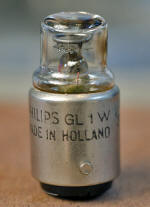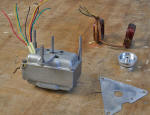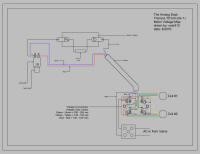-edible zone-
*Coil testing and replacement
*E50 sn 48083
 Checking ohms readings of the stator coils
Checking ohms readings of the stator coils
- * Coil #1:
- black - yellow: 55.5 ohms
- black - red: 86.2 ohms
- black - green: 265.5 ohms
- Coil #2:
- black - yellow: 53.5 ohms
- black - red: 81.5 ohms
- black - green: 259.7 ohms
It is the differences in readings between coil 1 and 2 that we are looking for. Preferably, all comparisons would be closer than a 2 ohm difference
Differences in readings between
coil 1 and coil 2:
- black - yellow: 2 ohms
- black - red: 4.7 ohms
- black - green: 5.8 ohms
*Strobe Resistor:
* reading: 37 K-ohms. Should be within 10% of factory spec: which is
33 K-ohms
reading: 37 K-ohms. Should be within 10% of factory spec: which is
33 K-ohms
Above: The new coils arrived from AudioSilente. Delivery was very quick. The order was on a Friday and delivery was on the next Tuesday. From Rome, Italy to Seattle, Washington in 5 days!
Ohms check on the new coil set:
- Coil 1
- Black - yellow: 22.3 ohms
- Black - red: 70.1 ohms
- Black - green: 102.8 ohms
- Coil 2
- Black - yellow: 22.4 ohms
- Black - red: 70.2 ohms
- Black - green: 103.2 ohms
*These are very close resistance reads, and with the new coils installed, and all previously replaced parts in their places, the initial power-on resulted in a motor that came up to speed in one rpm!
*Further notes - anecdotal trouble shooting.
There was this
one turntable, chassis # 13943 that came to me with a dead motor. I
restored it to operating condition after I had replaced the stator coils
with a new set from AudioSilente in Rome, Italy. However there were
further troubles. The trouble was low power output at the rotor shaft,
and I was having trouble identifying the source of it. I finally found
the problem to be the blue wire that carries voltage to the one post on
the strobe bulb. That one wire, when removed from the harness and looked
at closely in good light the copper wire had - deteriorated / broken up
- in various spots along its length. The result was poor current flow to
the lamp and thus reducing the amount of volts getting through to the
motor. The solution was to replace the wire with one of the same gage
but new and undamaged. That solved the problem. Lesson learned was to
always inspect all wires for damage/defects in the motor circuits.
(Copper hook-up wire is what is needed. Keep the color coding same as
the schematic.)
Another thing that can fool you into thinking
your motor isn't working right; Motor/bearing lube gets splashed onto
the idler wheel and results in loss of traction between the wheel and
the driven inner rim of the iron flywheel. The lesson learned is to keep
the interior of the chassis under the flywheel spotless clean and free
of any oil residue. Pay attention to this detail when applying lube to
the main bearing. To clean the oil off of the inner platter I will use
either alcohol or acetone. To clean the rubber idler tire I will use
lacquer thinner. It is a tad 'hotter' than the acetone and softens the
rubber nicely.
Above: TD124 volt map
__________________________________________________________horizontal rule
MkII motor grommet conversion kit from Audiosilente
* Parts from AudioSilente: For this page on the E50 we install the MKII
double-grommet conversion kit.
Parts from AudioSilente: For this page on the E50 we install the MKII
double-grommet conversion kit.
*
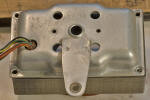 (click thumbnail to view full size image:
(click thumbnail to view full size image:
Above image: Top motor case. Note that the upper mounting stud has been removed by carefully drilling out the under-side rivet using a drill press. The goal being to remove the upper stud yet to not touch parent metal of the bracket with the drill. Narry a scratch is allowed.
* This is the mkII grommet kit from AudioSilente. The increased length of
each stud allows us to increase the number of mounting grommets from 3
to 6. Two per stud. Note also that Schopper in Switzerland
sells a similar kit for the same purpose. And so too did Mirko in
Huntington Beach, Ca. I've tried all three, they work as they should.
The choice of grommet material depends upon who you buy from and also
your preference. Material choice ranges from rubber to a poly
materal from Schopper and then, conical coil spring isolators from Hanze
Hi-Fi in NL. And then there is a silicone gel grommet from Gel Tech in
Japan. I'll have more comments about those in one my 13943 articles.
This is the mkII grommet kit from AudioSilente. The increased length of
each stud allows us to increase the number of mounting grommets from 3
to 6. Two per stud. Note also that Schopper in Switzerland
sells a similar kit for the same purpose. And so too did Mirko in
Huntington Beach, Ca. I've tried all three, they work as they should.
The choice of grommet material depends upon who you buy from and also
your preference. Material choice ranges from rubber to a poly
materal from Schopper and then, conical coil spring isolators from Hanze
Hi-Fi in NL. And then there is a silicone gel grommet from Gel Tech in
Japan. I'll have more comments about those in one my 13943 articles.
*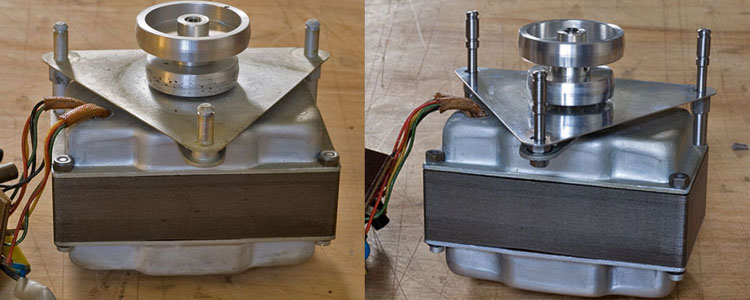
_____________________________________________horizontal rule
